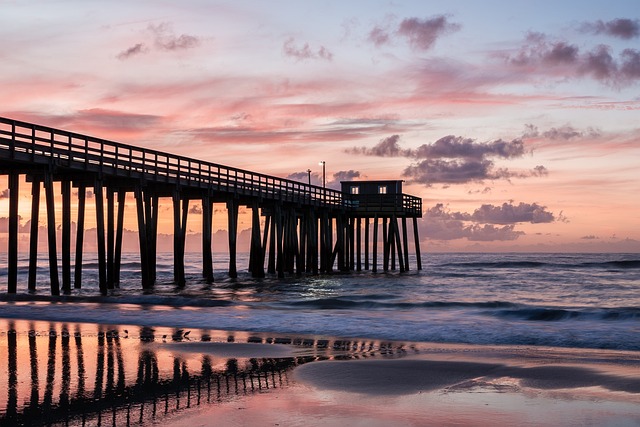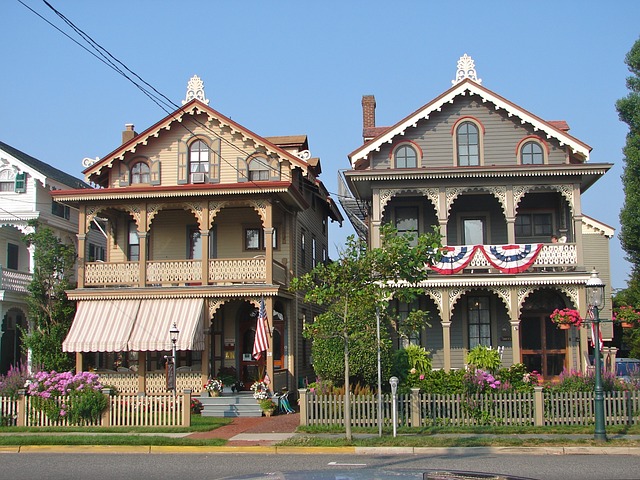The Sandy Hook Gateway National Recreation Area in New Jersey offers a unique blend of natural beauty, ecological diversity, and historical significance. This coastal peninsula features a variety of habitats including maritime forests, barrier islands, salt marshes, and pristine beaches, which are vital for numerous plant and animal species, including endangered ones that contribute to New Jersey's natural legacy. The area is also steeped in history with remnants of military fortifications from its role during key historical events like the Revolutionary War and World War II. Visitors can explore this transitional zone between the Atlantic Ocean and the mainland through a range of activities such as wildlife observation, birdwatching, educational programs on conservation, and enjoying the beaches. The area's historic sites like Fort Hancock provide insights into American military history, while the National Park Service's commitment to preservation ensures the sustainability of Sandy Hook's ecosystems for future generations. This makes Sandy Hook a must-visit destination in New Jersey for those interested in both nature and history.
Discover the natural splendor and rich history of New Jersey’s beloved Sandy Hook Gateway National Recreation Area. This article delves into the area’s diverse ecosystems, showcasing the unique flora and fauna that thrive within its borders. Explore the recreational activities available at this coastal gem, from serene beaches to hiking trails that offer panoramic ocean views. Delve into the historical significance of Sandy Hook, where remnants of its past coalesce with cultural heritage sites that narrate tales of maritime prowess and early settlements. Learn about the conservation efforts and environmental stewardship initiatives dedicated to preserving this New Jersey treasure for future generations. Embark on a journey through the landscapes and legacies of Sandy Hook, where every visit unveils another layer of its captivating allure.
- Exploring the Diverse Ecosystems of Sandy Hook Gateway National Recreation Area, NJ
- Recreational Activities and Attractions at Sandy Hook, New Jersey's Coastal Gem
- The Historical Significance and Cultural Heritage Sites within Sandy Hook Gateway National Recreation Area
- Conservation Efforts and Environmental Stewardship in Sandy Hook, NJ
Exploring the Diverse Ecosystems of Sandy Hook Gateway National Recreation Area, NJ

The Sandy Hook Gateway National Recreation Area in New Jersey offers visitors a chance to explore a rich mosaic of ecosystems along its extensive coastline. This natural treasure, a peninsula extending into the Atlantic Ocean, boasts an array of habitats from maritime forests to barrier islands, salt marshes, and pristine beaches. These diverse ecosystems provide critical habitat for a multitude of plant and animal species, including rare and endangered species that are indicative of New Jersey’s natural heritage. The area’s unique geography and its position as a transitional zone between the Atlantic Ocean and the interior of New Jersey make it a fascinating destination for both casual nature enthusiasts and serious scientists alike.
Visitors to Sandy Hook Gateway National Recreation Area can experience firsthand the ecological significance of this region, with opportunities for wildlife observation, birdwatching, and environmental education programs that highlight the importance of conservation in maintaining New Jersey’s biodiversity. The park’s natural beauty is complemented by its rich history, with remnants of military fortifications that dot the landscape, offering a glimpse into its past as a defense site during the Revolutionary War and World War II. Today, Sandy Hook serves as an outdoor museum where visitors can appreciate both its natural and historical value, making it a must-visit destination in New Jersey for those looking to immerse themselves in the wonders of nature and history.
Recreational Activities and Attractions at Sandy Hook, New Jersey's Coastal Gem

Situated in New Jersey, the Sandy Hook Gateway National Recreation Area offers a diverse array of recreational activities and attractions that cater to visitors of all ages and interests. This coastal gem is a treasure trove for outdoor enthusiasts, featuring pristine beaches with soft sands and gentle waves ideal for swimming, sunbathing, and surfing during the warmer months. The area’s extensive network of trails invites hikers, bikers, and equestrians to explore its scenic landscapes, offering breathtaking views of the Atlantic Ocean and the New York skyline.
For those interested in the natural and historical aspects of Sandy Hook, the recreation area provides opportunities for both passive and active recreation. The park’s history is palpable with its forts, including Fort Hancock, which offers a glimpse into American military heritage. Additionally, the area is home to the Sandy Hook Unit of Gateway National Recreation Area, which preserves unique ecological habitats and supports a variety of wildlife. Visitors can partake in fishing, bird watching, and educational programs that highlight the region’s biodiversity and importance as a natural sanctuary. Whether it’s enjoying the serene beaches, embarking on a nature hike, or delving into historical sites, Sandy Hook in New Jersey provides a rich experience for all who visit.
The Historical Significance and Cultural Heritage Sites within Sandy Hook Gateway National Recreation Area

Situated on a spit of land jutting into the Atlantic Ocean, Sandy Hook Gateway National Recreation Area in New Jersey holds a rich tapestry of historical significance and cultural heritage sites. The area’s history is deeply intertwined with the maritime traditions of the region, evidenced by its lighthouses, fortifications, and shipwrecks that bear witness to its past as a vital coastal defense outpost. Fort Hancock, within the recreation area, stands as a testament to the nation’s efforts to protect its shores, with structures like Battery 209 showcasing the engineering feats of the late 19th and early 20th centuries. These historical sites offer visitors a glimpse into the lives of those who once manned these defenses, as well as the evolution of military technology over time.
Beyond its military history, Sandy Hook Gateway National Recreation Area also preserves elements of New Jersey’s cultural heritage. The area’s diverse ecosystems and natural landscapes have been a source of inspiration and recreation for generations, reflecting the state’s commitment to conservation and environmental stewardship. The Sandy Hook Unit of Gateway National Recreation Area encompasses an array of habitats including beaches, salt marshes, and dunes, which are crucial for maintaining biodiversity and providing ecological education opportunities for visitors. This natural beauty, coupled with the area’s historical significance, makes Sandy Hook a unique destination that captures both the cultural and natural essence of New Jersey’s heritage.
Conservation Efforts and Environmental Stewardship in Sandy Hook, NJ

Located within the scenic state of New Jersey, the Sandy Hook Gateway National Recreation Area stands as a testament to natural beauty and ecological diversity. This sprawling expanse, with its significant coastal wetlands, dunes, and marshes, serves as a vital habitat for numerous species and an essential resource for both local communities and visitors. The conservation efforts here are multifaceted, focusing on the preservation of unique ecosystems and the protection of wildlife. These initiatives involve ongoing ecological research, habitat restoration projects, and the implementation of sustainable practices to ensure the area’s health and integrity for future generations.
The National Park Service, alongside local partners and volunteers, actively engages in stewardship activities that promote environmental awareness and education. In New Jersey, these efforts are particularly important given the region’s dense population and the consequent pressures on natural habitats. Through programs like invasive species removal, native plant cultivation, and monitoring of ecological conditions, the Sandy Hook Gateway National Recreation Area not only preserves its current state but also enhances it for the enjoyment of all. These conservation strategies are integral to maintaining the area’s biodiversity and ensuring that New Jersey’s natural landscapes remain a source of inspiration and recreation for years to come.
